#dominique. | profile.
Explore tagged Tumblr posts
Text

Dominique Lavanant on the set of Désiré (1996) directed by French director Bernard Murat, based on the Sacha Guitry's play by the same title.
Photo by Fabián Cevallos.
61 notes
·
View notes
Text
Character profile - Ingres

GENERAL DISCLAIMER: please keep in mind that I got access to these game profiles from gamerch, but unfortunately not all of them have all the information. Wherever you see a "//", it's because that info wasn't on the site and I couldn't find anyone who unlocked it. If you happen to have it, please send it to me! Also, some characters will have more infos than other because they had more cards in the game.
Other note: know that, in this case, "strength" is their painting technique or what they use in paintings.
Name: Ingres (Jean-Auguste-Dominique Ingres)
CV: Toyonaga Toshiyuki
Catchphrase: "A Meticulous Gentleman Who Puts Precision at the First Place"
Hobby: Measurements, puzzles
Likes: Accurate and precise things, rulers, geometric patterned items, the scarf given by Raffaello
Dislikes: Rough things, Delacroix
Height: 175 cm
Birthday: August 29th
Favourite food: Full course meal
Disliked food: Ice cream
Strength: Carefully composed, accurate and detailed drawings
Special skill: Violin, keeping things neat and tidy
Relationships with artists: He hates Delacroix, who is so contrary to his sense of beauty. Renoir and Rubens have the same tastes as him. He respects Raffaello like a god.
How he became an exclusive member: When his confident work, which he had been fully prepared to present, was critically acclaimed, he fell into ruin and received a scouting offer from the owner. Unable to give up his passion for painting, he accepted the owner's invitation and signed a contract subject to certain conditions.
What he wants to do: //
Sleeping time: "Well... I have chosen that it will be 8 hours, 0 minutes and 0 seconds."
What he wants now: "A clock that never gets delayed for a second. It would be especially wonderful if it could also measure it accurately."
#palette parade#palette parade tl#palepare#palepare tl#translation#character profile#character profile tl#ingres#jean auguste dominique ingres
1 note
·
View note
Text
There is no collective noun for rapists but spend a week at the Pelicot trial and you wonder why. As the early morning queue of women who’ve come to support Gisèle Pelicot passes through security at the Palais de Justice, Avignon, you spy men with downturned faces scurrying across the lobby past the press. In court they sit on the left, clustered around a glass box containing more men, those in custody for the gravest crimes. Since there are 50 in total, the alleged rapists have been tried in batches and I’m just here for the final seven: Boris, Philippe, Nicolas, Nizair, Joseph, Christian, Charly.
Plus Dominique Pelicot himself, who invited them all into his marital bedroom, where he had his wife waiting, drugged and naked, and who joined in and filmed it all. Pelicot, 71, crumpled and fat now, but with a residual bulky power, sits sullenly alone with his guard in a separate glass box, protected from the other men who blame and detest him. Often after lunch he appears to doze off.
Such nondescript men. Grizzled, middle-aged (the mean is 47 years old), smart-casual in windcheaters or leather jackets and their best trainers, like minicab drivers waiting for fares. Ordinary men in many respects, not vagrants, junkies or career criminals. This week’s seven includes a fireman, an electrician and a journalist; several are fathers, two were keen weightlifters, one bred dogs. French trials helpfully begin with a personality profile formed from interviews with the men, their friends and colleagues. Poverty, domestic violence and mental breakdowns feature, but also that a man is “kind” or “gentle”, had a lovely childhood, adored his grandparents or is devoted to his mum.
Yet each one had sex with an unconscious woman, that is beyond doubt, thanks to Pelicot’s camera mounted on a tripod beside the bed, and by his own admission. “I am a rapist,” he has declared, “like the others in this room.”
From the Pelicot affair have come demands for reform to French rape law, for sexual violence to be treated more seriously, for an investigation into “chemical submission” — the coercive use of sedatives. But one question overshadows all others. How many men would have done the same? If Pelicot could recruit at least 70 willing participants (a number could not be identified) within a 25-mile radius of Mazan, the Provençal town where the couple retired, how many in the whole of France? As I walk through Avignon with Juliette Campion of radio station France Info, who bears the strain of reporting this case since September, she gestures to a bureau de tabac: “You think, ‘Would a guy in there have raped Gisèle? Or men in the boulangerie or those on the street?’ Women are looking at men differently: they’re asking, ‘Could you or you or you?’ ”
On the right of the court, behind her counsel of three serious, dark-haired young men, is Gisèle Pelicot with her female companion from victim support, leaning on the wall, as far from the men as the room allows, but facing her ex-husband. Her composure is remarkable. Although clearly tired and strained, she retains a quiet vivacity reflected in her clothes. Instead of shrinking away in black, she dresses each day as if meeting friends for drinks on a sunny terrace. A chic scarf, a faux fur bag, patent leather boots. Clothes that say, “I still have a life.” Every evening, when women line up to clap her out of court, she speaks to them warmly, neither reticent nor relishing the attention. Every day she walks through the cobbled streets past graffiti saying, “Gisèle, les femmes te remercient” (Gisèle, women thank you) to lunch at the same excellent brasserie, and people turn to gaze at her in awe.
The extraordinary woman who refused to be silenced
The humiliations of Gisèle Pelicot have a mythic quality. This is a woman who discovered the man she married aged 20, with whom she had three children and seven grandchildren, waited until she was deeply asleep before removing her pyjamas, dressing her in “sexy” underwear or writing on her buttocks, “I am a good submissive bitch,” then he let a stranger penetrate her inert body, filmed it, washed her intimately and replaced her pyjamas. This is a woman who thought she was going insane, had Alzheimer’s or a brain tumour, whose children thought she was dying, who stopped driving and going out alone, who slept all day and once woke puzzled why her hair was shorter. “But madame,” said her hairdresser, “you came in yesterday.” This is a woman who had mysterious gynaecological problems, including a swollen cervix (and still lives with four STDs), who thought her husband wonderful for accompanying her to medical tests, including an MRI.
This is a woman who, when her husband was arrested for “upskirting” in a Leclerc supermarket and police found the contents of his phone, discovered her whole 50-year marriage was a travesty, that he’d raped her in a service station car park, on Valentine’s Day and on her 66th birthday, and may have raped their daughter too. This is a woman who has listened to legal arguments about whether a man put his tongue inside or merely kissed her vagina, who heard another man say he’d only returned to rape her a second time because he couldn’t find anyone better, who sits in a courtroom while three giant TV screens show clips of her body being coldly humped by yet another “ordinary” guy.
Yet this is a woman who gathered up every scrap of her humiliation and with it constructed a mirror that she holds up defiantly to the court and to French society itself. “Shame must change sides,” she said, and in insisting the entire trial be conducted openly, that the worst men can do to women is witnessed by the whole world, she has done exactly that.
I ask many women I meet in Avignon how men in their lives regard the accused. They say they call them losers and freaks, that these are men on the margins, with no relation to themselves. But, along with the testimony I hear, the people I talk to believe this case raises many questions about French sexual mores. Whatever the decision later this month by five judges — there is no jury — Gisèle Pelicot will never be forgotten.
The court turns to Christian L, a fireman with a straggly castaway beard, who speaks from the glass box because after he was arrested, police found 4,000 child sex abuse and zoophilic images on his hard drive. We hear from his girlfriend, Sylvie, a small blonde in a grey hoodie, who says he’s a wonderful man, and is suspected of destroying evidence. Christian L recalls the victims he watched die in fires, the coffins of 11 colleagues he carried, the mental breakdowns that ensued. He was married but after his two daughters were born says he went off sex with his wife and turned to libertinisme. Strange, I think, that the French have coined this noble, philosophical concept, with its whiff of the barricades, to describe what we call swinging or dogging.
Like all the men, Christian met Pelicot through coco.fr — the murky, unmoderated site since closed down and now the focus of many major police investigations — on a forum called À son insu (without her knowledge). Christian L had already enjoyed “Sleeping Beauty” encounters with ten other couples. He spells out the rules: that you only dealt with the husband, sending him photos for approval, and during the sexual encounter he ran the show. Sometimes the wife woke up, other times not. How did he know, asked Gisèle’s lawyer, Stéphane Babonneau, that she consented?
“In a libertine encounter,” Christian L explained, “it is the husband’s responsibility to ensure consent.”
But how could you be sure?
“Are we expected to sign a contract?” Christian L spluttered.
“You could ask the woman,” Babonneau suggested.
How the case could change French law
Given the overwhelming video evidence, the defendants can only claim Pelicot deceived or drugged them, or they believed Gisèle was collaborating in a game. If this case were before a British court, rape would be decided by two tests: whether Gisèle had “capacity to consent” (tough to argue given Pelicot admits to drugging her) and whether the men had “reasonable belief” in her consent. Unlike most European countries, French rape law has no concept of consent. Rather, it is defined as penetration “by violence, constraint, threat or surprise”. (The prosecution case rests on a convoluted definition of surprise.)
But rather than demand consent be added to the law, French feminists are divided. Some agree with President Macron, who supports change; many others argue that consent would put the onus on the victim to prove her conduct was not an invitation. This seems an odd objection, especially as the whole purpose of the video evidence is to show no one could believe Gisèle capable of consent, given she was so lifeless one man asked Pelicot, “Is your wife dead?”
Alice Géraud is the author of Sambre, an investigation into how, due to the indifference and cruelty of police, a caretaker called Dino Scala in northern France managed to rape 54 women over a period of 30 years. “The Pelicot case with 50 defendants and one victim feels a strange inverse of Sambre.”
Géraud believes the Pelicot affair could provide the same impetus for change as a famous 1974 case of two Belgian tourists, Anne-Marie Tonglet and Aracelli Castellano, who, camping near Marseilles, were brutally raped by three local men. As was normal practice, the crime was downgraded from felony to misdemeanour on the basis the victims eventually stopped resisting. But the women, a lesbian couple, persisted and thanks to their feminist lawyer, Gisèle Halimi, it became the first rape case to be heard in the higher assizes court. Like Gisèle Pelicot, the women waived their anonymity. “We believe that it’s one thing for a man to rape,” said Halimi, “and another to know it’ll get around his village, his work, the papers.” Shame changed sides: the men were jailed and the French criminal code was rewritten defining rape as a serious offence.
For Géraud, the greatest current injustice is that whether a man has raped one women or 50, the maximum sentence is 20 years (here a serial rapist can be jailed for life). “This is law made by men,” she says, “with a grave lack of knowledge of rape culture.” She is scornful too about libertinisme as a universal excuse for male sexual exploitation. “Libertinisme was why Coco existed for so long,” she says. “It is the justification for prostitution, for the porn industry.”
Charly A is the youngest of all the defendants, just 22 when he first entered the Pelicot house. Small, bearded, now 30, we learn his childhood was chaotic, his father an alcoholic, his mother had many sexual partners; there are hints of abuse. “This is a family of secrets,” concludes the personality profiler. A psychiatrist adds he is immature, struggles to sustain relationships and instead consumes porn, “especially the Milf [Mother I’d like to f***] category with mature women”. In 2016, he made contact with Pelicot via Coco: “He said his wife would be lying there pretending to be asleep, he doesn’t tell me more.”
Over time Pelicot asks Charly if he knows anyone they could drug for sex and he proffers the only woman in his life — his own mother. Pelicot gives him pills (which Charly claims to have thrown away), shows him how to crush them, keeps pressing him to use them. “When can I come and we f*** your mother?” he asks in one video, but Charly keeps stalling, saying his brother is at home. Yet he returns to violate Gisèle, always with Pelicot, once with another man, a total of six times. “Did you feel like you were in a porn film?” asks Babonneau. Charly shakes his head.
Until this point, very late in the trial, the influence of internet pornography has barely been explored. The court only notes paedophiliac images, not “normal” usage. Yet Mathieu Lacambre, a psychiatrist who evaluates Charly A, remarks how porn sites not only push users to more extreme content but to enact porn fantasies in real life. “Until now Charly A was behind the screens,” he says. “Now [in Gisèle] he has an object served up on a platter a few miles from home. The sleeping princess Milf, voilà.”
A rented home in a quiet cul-de-sac
I drive out to Mazan, a lovely honey-stoned French village set in the vineyards below Mont Ventoux, where the Pelicots retired from Villiers-sur-Marne, a Paris commuter town where he was electrician and she was a manager at EDF. I imagine Gisèle browsing the little boutique, dropping into the beauty salon, sipping an aperitif outside the bistro. The home they rented for ten years is five minutes away in a quiet cul-de-sac of four houses behind tall cypress trees. It is lemon yellow with blue shutters, a pool, a very prominent alarm system, and new tenants. Given how many men knew her address, Gisèle fled four years ago for her own safety, with just a suitcase and her dog.
Today an immense cloud of migrating starlings swoops over the house like pixels in a photograph. This was where their grandchildren loved to visit in the summer, but also the centre of Dominique Pelicot’s porn operation. For what else was this grotesque man but a pornographic auteur?
We leave our car, just as Pelicot instructed the men, in the sports ground car park, by the bottle bank. I think of them texting their arrival, then creeping down the lane. (One man made his girlfriend wait in the car.) Pelicot would meet them at the door by the light of his phone, tell them to undress in the dark living room and warm their hands on a radiator. (They’d been instructed to be clean, not smell of cigarettes or wear cologne.) Then they were led into a bedroom with a TV, a chest of drawers, a bed with a naked Gisèle motionless on white sheets, and a mounted camera.
Whatever followed next was carefully orchestrated by Pelicot, a director urging on actors in stage whispers, since the objective was to do what they desired without waking Gisèle. Pelicot would tell them how and when to penetrate her, or hold his wife’s gaping mouth to facilitate oral sex. Given four Temesta (lorazepam), a powerful anti-anxiety drug he’d crushed into her wine or ice cream, his wife was like a patient on an operating table. Even so, if her arm gave an involuntary spasm,the men would scuttle from the room. A friend who has sat through many court videos says it was Pelicot ordering the humping men to go doucement — softly — that upset her, since she knew this was not out of tenderness for Gisèle.
All the while the camera rolled. Why did these men agree to have their crimes recorded? They say it was part of the deal, that Pelicot told them Gisèle was shy and liked to watch the sex later. But perhaps also because, in taking part, these men were promoted from porn consumers to creators. Filming was central to their fantasy. When Christian L finally climaxes he turns to give the camera a cheery thumbs-up.
For Pelicot, each film added to his oeuvre. Police discovered a carefully curated archive of 20,000 images and videos on hard drives and memory sticks showing 200 rapes. He gave each film a title like “Squirt on the ass”, “Cock in mouth” or “Jacques fingering”. This man, once caught by his daughter-in-law masturbating at his computer, was now a porn impresario.
The question at the centre of the case
Why did Pelicot do all this to a wife he professed to love, whom he called “a saint”? Was it to punish Gisèle for an affair early in their marriage (although he was serially unfaithful himself)? Or because when he’d asked her to join him in the libertinisme scene she’d refused — so he devised a way to make her. But Gisèle was not his first victim: Pelicot has admitted to the rape of an estate agent, using ether to drug her, in 1999, and will be tried for the rape/murder of another young estate agent, Sophie Narme, in 1991. The French police cold case bureau is investigating his possible links to many other unsolved crimes.
But as the “Without her knowledge” forum suggests, his was not a unique fantasy. The Pelicot case has illuminated the issue of “chemical submission”, not only drinks being spiked by strangers in bars, but drugs used to control partners within relationships. The French health service is noted for being blasé about prescribing heavy-duty medications, which is how Pelicot stockpiled his vast stash of Temesta.
Documentary-maker Linda Bendali has made a film for French TV about chemical submission, featuring seven cases, including a 13-year-old girl drugged by her father with medicine supposedly for her allergies, put in lingerie and raped over two years, and a 60-year-old woman drugged then raped at home by a man she was mentoring at work. “I’ve looked back at 30 years of press reports of rape,” says Bendali, “which includes dozens of women saying they woke up — mainly with men they know— unable to remember what happened.”
The Sleeping Beauty scenario, she says, is not merely a means for a man to get easy sexual access, but a way to enjoy absolute domination. “You are not even giving her the chance to consent,” says Bendali. “You can do anything you want to a drugged woman, for as long as you want. You can dress her how you want. These men want total power.” Pelicot is typical in filming his crimes: “Pictures are trophies. He was driven by a mix of desires for blackmail and voyeurism.”
Gisèle’s daughter, Caroline Darian, who was also drugged and photographed naked by her father, is heading a campaign on chemical submission, demanding police take samples of hair from rape victims, the only way sedation can be proved.
In court, I hear another psychiatrist tasked with assessing whether each of the final seven defendants has the profile of a sexual abuser. One by one, he exonerates the men, saying they are not dangerous or likely to reoffend, to the growing exasperation of Gisèle’s team. Then he reaches Charly A. “He doesn’t search [for victims] systematically,” says the psychiatrist. “He’s not a predator.” Finally, Babonneau explodes: “Six times with a sleeping woman and he’s not a sexual abuser?” The men do not identify as rapists because, like this psychiatrist, they define rape as frenzied sexual violence, not an opportunistic act performed to whispers in a private home. As one defendant put it, “It’s her husband, his house, his room, his bed, his wife.”
Women unite in the town of Mazan
Both in religious and political terms, Mazan is a conservative town: for 500 years it was part of a papal enclave and in the recent French election voted heavily for Marine Le Pen. Villagers regarded the Pelicot case with horror and sympathy which turned quickly to resentment when press named it l’affaire Mazan. Amid longstanding families who’ve known each other for generations, the Pelicots were outsiders who’d brought disgrace into a rural community. Tired of inquiries, the mayor, Louis Bonnet, 74, told the BBC, “It could have been far more serious. There were no kids involved. No women were killed.”
At the Lucky Horse Ranch outside Mazan, women victims of sexual violence receive equine therapy. I’m sceptical at first about how grooming and riding horses could help rape victims, but somehow these large, placid animals are calming and restorative. Here I meet Latika, 33, who at first was too timid to touch a Shetland pony, but now sits high on a saddle for our photograph.
Latika was separating from her husband, the father of her two children, but still sharing a house. He was violent, hitting her daughters, putting her in hospital with cuts and a broken rib. Two years after they’d last had sex, she woke to find him inside her. She believes the sweet tea he often gave her was laced with sedatives, but that night she hadn’t drunk it all. She realised he’d been drugging her for years — her mother recalls finding her deeply unconscious early in her relationship — and, worse, she was pregnant with a third child. She told the police, who addressed the domestic violence but ignored the rape. Her husband fled to Guadeloupe and she was left traumatised, fearful of leaving the house.
“I didn’t feel people really believed what had happened to me until Gisèle Pelicot spoke out,” says Latika, who has since made the police reopen her case. In October, as women across France holding white flowers protested in support of Gisèle, Latika headed the local march into Mazan and the next day Gisèle herself visited the ranch. “She said it is almost unbearable to return to this place where terrible things happened,” says Latika, “but she wanted to thank us. She told me, ‘I didn’t know the meaning of my life before this happened — but I do now.’ ”
Watching Gisèle take such sustenance from her supporters, you wonder how she will cope when the trial finally ends. She is writing a book and could, if she chose, become a global campaigner. “There is something particularly powerful,” says Linda Bendali, “about her being an older woman — she represents all our mothers. All generations identify with her.” But those close to Gisèle say that, at 72, she may just return to a quiet life of friends, grandchildren and her garden, in the secret location where she now lives.
But she is already an icon of courage for the women who come from across France and beyond just to watch the trial on a screen in an overspill room. Some want to witness history, a few enjoy the sensational evidence like tricoteuses at the guillotine, but many have risen at 5am, taking a day off work, to support a woman they deeply admire. Marion Spiteri and Amélie Planche, both 24 and law graduates, feel the case opened their eyes. “How can it be,” Spiteri says, “that so many men did this without her consent?” “It is terrifying,” Planche adds, “that a woman cannot even trust her own husband.” They tell me, astonishingly, that neither they nor their friends ever go to the toilet in a bar or club alone.
But then the nation of libertinisme lags behind in its attitude to violence against women. Until 2021, France did not even have an age of consent, effectively decriminalising even incestuous relations between children and adults, allowing several high-profile child abusers, including firemen who groomed a 13-year-old girl, to evade rape charges. Each time a prominent Frenchman is accused of rape — whether politician Dominique Strauss-Kahn or, currently, actor Gerard Dépardieu — famous French actresses leap to defend him. This is the nation that convicted child rapist Roman Polanski fled to from America, and is still fêted. The #MeToo movement was regarded by many as a wave of Anglosphere prudishness, contrary to the spirit of French seduction. So what can the Pelicot trial achieve?
I meet feminists from Les Amazones d’Avignon, the creators of graffiti across the city supporting Gisèle. (So as not to spoil the city walls, they write slogans on paper that can be removed.) Their latest reads “20 ans pour chacun” — 20 years for each one. I suggest a drink in a café nearby: “Not in there,” says one Amazone, “that’s where all the rapists go.” Blandine Deverlanges, 56, is part of the Coalition Féministe Loi Intégrale putting 130 proposals about sexual violence before the French parliament, including a ban on lawyers harassing victims in court. They are disgusted the defence asked Gisèle why she swam naked in her own swimming pool.
“This is a trial,” says Deverlanges, “of one extraordinary man, the monster Pelicot, and many ordinary men.” And as we talk I see a group of them emerge nervously from their favoured café and head back to the court. A collective noun for rapists? A violation, a banality, a shame.
(archive)
682 notes
·
View notes
Text
https://www.nytimes.com/2024/09/02/world/europe/france-husband-rape-drug-trial-mazan.html
For years, she had been losing hair and weight. She had started forgetting whole days, and sometimes appeared to be in dreamlike trances. Her children and friends worried she had Alzheimer’s.
But in late 2020, after she was summoned to a police station in southern France, she learned a far more shattering story.
Her husband of 50 years, Dominique Pelicot, had been crushing sleeping pills into her food and drink to put her into a deep sleep, the police said, and then raping her. He had ushered dozens of men into her home to film them raping her, too, they said, in abuse that lasted nearly a decade.
Using the man’s photographs, videos and online messages, the police spent the next two years identifying and charging those other suspects.
On Monday, 51 men, including Mr. Pelicot, went on trial in Avignon, in a case that has shocked France and cast a spotlight on the use of drugs to commit sexual abuse and the broader culture in which such crimes could occur.
The accused men represent a kaleidoscope of working-class and middle-class French society: truck drivers, soldiers, carpenters and trade workers, a prison guard, a nurse, an I.T. expert working for a bank, a local journalist. They range in age from 26 to 74. Many have children and are in relationships.
Most are charged with raping the woman once. A handful are accused of returning as many as six times to rape her.
The victim, Gisèle, who has divorced her husband and changed her surname since his arrest, is now in her 70s.
Since his arrest, Mr. Pelicot, 71, has “always declared himself guilty,” said Béatrice Zavarro, his lawyer. “He is not at all contesting his role.”
Other defendants have denied the rape charges, with some arguing that they had the husband’s permission and thought that was sufficient, while others claimed they believed the victim had agreed to be drugged.
When the police showed Gisèle some of the photographs they say her husband had carefully classified and stored, she expressed deep shock. She and her husband had been together since they were 18. She had described him to the police as caring and considerate.
She had no memory of being raped, by him or the other men, only one of whom she recognized, she told the police, as a neighbor in town.
The first time she will consciously witness the rapes, her lawyer Antoine Camus says, will be in the courtroom when the video recordings are played as evidence.
The trial comes at a moment of heightened scrutiny of the handling of sexual crimes in the country. Rape is defined in French law as an “act of sexual penetration” committed “by violence, coercion, threat or surprise.” A number of feminist lawmakers want to amend that wording to say explicitly that sex without consent is rape, that consent can be withdrawn at any time, and that consent cannot exist if sexual assault is committed “by abusing a state impairing the judgment of another.”
“There is a kind of naïveté on the topic of predators in France, a kind of denial,” said Sandrine Josso, a lawmaker who led a parliamentary commission into what is known in France as “chemical submission” — drugging someone with malicious intent. She started the commission after she says she became the victim of a drugging last year. A senator is being investigated on accusations that he slipped Ecstasy into her Champagne.
Ms. Josso hopes that the Avignon trial will draw attention to the use of drugs to prey on women, and also shed light on the wide profile of predators. “They could be your neighbors, without falling into paranoia,” she said.
Mr. Pelicot seemed like a classic man next door. He was a trained electrician, an entrepreneur and an avid cyclist. His middle child and only daughter, Caroline Darian, her pen name, described him as a warm and present father in a book published in 2022 about the case, “And I Stopped Calling You Papa.” She tried to turn her family trauma into action, forming a nonprofit association, “Don’t Put Me to Sleep,” to publicize the dangers of drug-facilitated crimes.
Her father, she wrote, was the one who drove her to school, picked her up late from parties, encouraged her and consoled her. Her mother was the stable breadwinner, working as a manager in a Paris-area company for 20 years.
When Gisèle retired, they moved to a house with a big garden and pool in Mazan, a small town northeast of Avignon. The couple regularly hosted their three children and grandchildren for summer vacations peppered with late dinners on the terrace, where the family debated, held dance competitions and played Trivial Pursuit.
“I think of us as happy,” his daughter wrote. “I thought my parents were.”
None of them harbored any suspicions. Then, in 2020, three women reported Mr. Pelicot to the police for trying to use his camera to film up their skirts in a grocery store, and he was arrested.
The police seized his two cellphones, two cameras and his electronic devices, including his laptop, before releasing him on bail.
On the devices, the police say they found 300 photographs and a video of an unconscious woman being sexually assaulted by many people. They said they also found Skype messages in which the man boasted of drugging his wife and invited men to join him in having sex with her while she was unconscious.
Over the course of their investigation, the police found more than 20,000 videos and photographs, many of them dated and labeled, in an electronic folder titled “abuse.” The timeline they built began in 2011. The list of suspects grew to 83.
Two months after his initial arrest, Mr. Pelicot was arrested again and charged with aggravated rape, drugging and a list of sexual abuse charges. He is also accused of violating the privacy of his wife, daughter and two daughters-in-law on suspicion of illegally recording, and at times distributing, intimate photos of them.
If he is found guilty, he faces up to 20 years in prison.
During interviews with the police, the details of which were included in an overview of the case by the investigative judge, Mr. Pelicot said he began drugging his wife so he could do things to her, and dress her in things, that she normally refused. Then he started inviting others to participate. He said he never asked for or accepted money.
He met most of the men, the investigating judge’s report stated, in a chat room on a notorious, unmoderated French website implicated in more than 23,000 police cases in France alone from 2021 to 2024. It was finally shut down, and its owner arrested, in June after an 18-month investigation stretching across Europe.
The chat room where most of the men met Mr. Pelicot was called “a son insu,” which means “without their knowledge.”
Over the years, Mr. Pelicot told the police, he developed rules for the visitors to ensure that his wife did not wake: no smoking or cologne; undress in the kitchen; warm hands under hot water or on a radiator, so their cold touch would not jolt her. At the end of each night, according to the investigating judge’s report, he cleaned his wife’s body.
Of the 83 suspects, the police identified and charged 50.
Only one of the men is not charged with rape, assault or attempted rape of Mr. Pelicot’s wife. Instead, that man is accused of following the same model, and drugging his own wife to rape her. Mr. Pelicot is also charged with raping the man’s wife while she was drugged.
Five of the men also face charges for possessing child sexual abuse imagery.
Mr. Pelicot is also being investigated in the rape and murder of a 23-year-old woman in 1991 and the attempted rape of a 19-year-old in 1999. He admitted to the attempted rape, according to Florence Rault, the lawyer representing the victims in both cases, but denies any involvement in the 1991 homicide.
The story has prompted some soul-searching among doctors, since Gisèle had visited gynecologists and neurologists over a series of mystifying symptoms, but had received no diagnosis, according to her daughter.
“What I found disturbing for us doctors was that no doctor considered this hypothesis,” said Dr. Ghada Hatem-Gantzer, a well known obstetrician-gynecologist and expert in violence against women. She and a pharmacist, Leila Chaouachi, have now developed training for doctors and nurses on the symptoms that victims of drug-facilitated assault can experience.
Contrary to popular belief, most cases occur at home, not at bars, said Ms. Chaouachi, who runs annual surveys on such offenses in France. Most victims are women, the surveys show, and around half of the victims do not remember the attack, because of blackouts, she said.
In the case going to court in Avignon, some of the accused admitted guilt to the police. According to the investigating judge’s report, many claimed that they were tricked into having sex with a drugged woman — lured by a husband for a three-way encounter and told she was pretending to sleep, because she was shy.
Several said they believed that she had consented to being drugged and raped as part of a sex fantasy. Some said they did not believe it was rape, because her husband was there and they believed he could consent for both of them.
“It sends shivers down the spine regarding the state of affairs in French society,” said Mr. Camus, who is also representing Ms. Darian and many other members of the family. “If that’s the conception of consent in sexual matters in 2024, then we have a lot, a lot, a lot of work to do.”
418 notes
·
View notes
Text
Women cannot trust any men, never. Not even the ones who they are married to nor the father of their children. I just saw an article of an elderly french man, Dominique Pelicot, who drugged his wife into a state of coma for 10 years and offered her to almost 80 men so she would be repeatedly raped by them over and over while he filmed it all.
This woman was his wife, the Mother of his three children and he did not gave a shit before offering her to other men on a special app for men who especifically were searching to have sex with non consenting partners. He gave her more than 400 sleeping pills, he could've killed her and did not give a fuck.
He just admitted it outright as soon as he was caught and he was only caught because he was seen taking upskirt pictures in the mall which led to an investigation. Not only that, he is now accused of the rape and murder of a female state agent and the attack of another state agent that could escape and the dna seems to match to his.
Almost 80 men were contacted for ten years. 80. From ages 23 to 73, nurses, a local councillor, a prison guard, journalists, a soldier, a firefighter, a civil servant and only 50 were identified. They all knew what was happening, they had a system to make sure the poor woman couldn't tell what was going on and now they claim that Dominique "tricked" them.
From all the men Dominique contacted only Three refused to participate but still didn't do anything even though they knew about the crime.
We can't trust no men, none of them. Look at all the "nice normal men" That participated in such an abhorrent act that now pretend to have been tricked into despite the apps/forums being proof they KNEW what was going on. These men used their upstanding profiles in the community to commit a crime constantly for ten years without being suspected and will probably try to use it to escape punishment.
We have to send all our strength to Giselle, the victim, who not only is taking all of them to justice but who also doesn't want the trial to be on closed Doors. She wants everybody to know what happened to her to create consciense, to make sure the perpetrator's faces are known. She is so strong and her and her children deserve the world.
#radfem safe#sexism#Giselle Pelicot#news#male violence#male entitlement#men can't be trusted#all men#all men are predators
106 notes
·
View notes
Text
Dozens of men, including the ex-husband of Gisèle Pelicot, were Thursday found guilty of raping and sexually assaulting her in a historic trial that shocked France. Speaking with journalists in the southern town of Avignon after the verdicts were read, Pelicot, 72, said the outcome of her case gave her faith in a future in which “everybody, women, men can live together in harmony, in respect and in mutual understanding.” Pelicot, who has become a hero to many in France for choosing to waive her right to anonymity and highlight the crimes orchestrated by her husband, added that she had fought the case with her children and her grandchildren in mind “because they are the future,” according to a live translation by NBC News’ British broadcasting partner, Sky News.
62 notes
·
View notes
Text
S.W.A.T. (CBS Series)
Dominique Luca x fem!reader
Reassurances
1.7k+ words | fluff | Luca's fellow S.W.A.T. members tease him for dating someone who is younger and out of his league. Though he knows they mean well, sometimes he needs your reassurances.
All You Want and More
3.1k+ words | fluff | When Luca finds out that you have never celebrated your birthday, he sets out to make your day perfect.
You Invite It
3.7k+ words | angst to fluff | Despite your sunny and smiley personality, Luca and another man get angry with you during a night out with 20-David. When Luca comes to apologize, you shy away from him, and he has to tell you how he feels before you will accept his help.
Let Me Help
2.6k+ words | angst to fluff | When Los Angeles is hit with a freak cold front and your apartment loses heat, you don't ask for help. Luca sees how sick you are and pays you a visit which ends with him taking you back to his house to heal.
Driver's Seat
1.2k+ words | fluff | At a classic car show, you meet the only gentleman in attendance and bond over a mutual love for cars.
Do You Want to Keep a Secret?
2.5k+ words | fluff | After Luca asks Street to stay out of the house for a while, Street gets tired and curious and accidentally crashes Luca's "book club."
Do You Want to Keep Another Secret? 1.6k+ words | fluff | After the team finds out about Luca's secret girlfriend, he invites them over to share another secret involving a ring and an important question.
Found Family
1.9k+ words | angst to fluff | When you finally meet Luca's team, you aren't expecting to run into a man you haven't seen or heard from in years.
Hiding Hugs
2.5k+ words | fluff | shy!SWAT!reader | 5 times you find refuge in Luca's arms, and the 1(st) time you show him why.
Surf Crazy
1.2k+ words | fluff | Luca takes you to your first professional surfing competition, and then invites you on another first.
Us or Them
3.8k+ words | angst to fluff | You and Luca go undercover as a couple, and when you're forced to get close, the truth slips out.
Fit Into the Family
1.3k+ words | fluff | After hearing all about you, Luca's team gets to meet you and learns that you're perfect for Luca.
Save Your Life
1.5k+ words | angst to fluff | The most terrifying part of Luca's life is also the best: being a single father. His daughter is in danger, and he relies on his team to save her.
Whole Again
2.2k+ words | angst to fluff | SWAT!reader | You're injured during a raid, but your boyfriend Luca doesn't know how bad it is. After you're separated and instructed not to speak, your team finds a way to let you comfort one another.
Surety of Ghos-ti
2.8k+ words | angst to fluff | pregnant!reader | You are held hostage, and Luca and his team have to save you and your baby.
Even If We Stay Here
1.5k+ words | angst to fluff | 50squad!reader | Luca isn't himself, and when you find out why, you remind him that you're always there, even if it's just as a friend.
Smart Enough
2.3k+ words | fluff/comfort | Street's cousin/LAPD analyst!reader | While staying with your cousin Street, you assist the LAPD in catching a serial killer, but discover you fit the victim profile. SWAT agrees to protect you, but Street finds out that you and Luca are closer than you seemed.
I Should Have Denied It
1.7k+ words | angst to fluff | 50-squadSWAT!reader | You've been arguing with your boyfriend Luca, and when you hear he's up for a promotion, your anger and fear of losing him cloud your judgement and lead you into danger.
All That Matters
2.0k+ words | fluff, brief angst | younger!reader | You're sweet, bubbly, and perfect for Luca. When people begin judging your relationship because of the age gap, you decide that you, Luca, and the love between you are all that matters.
150 notes
·
View notes
Text



. * ⋆ . · . ⋆ :₊ 𝒗𝒂𝒍𝒆𝒏𝒕𝒊𝒏𝒆'𝒔 𝒎𝒂𝒕𝒄𝒉-𝒖𝒑 𓂃 ࣪˖ ִֶָ♡ ‧⁺ . ♡ ⋆ . · . 𝒔𝒖𝒈𝒂𝒓 𝒂𝒏𝒅 𝒔𝒑𝒊𝒄𝒆 𝒆𝒅𝒊𝒕𝒊𝒐𝒏! 𝜗𝜚˚⋆
𓆩♡𓆪 it's that time of year again! this is my blog's third consecutive year of valentine's match-ups, a chance for you to be set up on a date with one of your favs! but this year is even more special as there are two parts to the event: sugar and spice! If you are 18+ you can enter both sugar and spice once each! 𓆩♡𓆪 SUGAR is the SFW and majority part of this event, open to everyone. SPICE* is the NSFW and smaller part of this event, available only to followers aged 18+ *spice info under the cut 𓆩♡𓆪 SUGAR! engagement can be unpredictable so entries will be chosen either one of two ways: 14 entries or less will make this a first-come first-served event! 14+ entries will see 14 winners chosen at random via raffle! 𓆩♡𓆪 SPICE! will only have 5 slots available and entries will be chosen via raffle regardless of engagement

₊˚⊹♡ 𝒔𝒖𝒈𝒂𝒓!
♡ start your message with "sugar!" and send me a description of yourself (sexuality, personality, hobbies, likes/dislikes, etc. any details to give a profile of yourself) and a fandom (or multiple fandoms!) of your choice from the list below. ♡ I'll tell you who would ask you to be their Valentine and why as well as the date they would take you on! ♡ you can enter by sending your information to my ask box! ♡ please keep in mind that entries for sugar are one per person and not one per blog. This is to make it fair.
♡ enter now for a Valentine's date!
・💌・꒰ CLOSES 10TH FEB. ꒱ ・💌・꒰ 3 LETTERS RECEIVED ꒱

. ♡ ⋆ . · . 𝒇𝒂𝒏𝒅𝒐𝒎 𝒍𝒊𝒔𝒕 𝜗𝜚˚⋆
𝐀𝐒𝐒𝐀𝐒𝐒𝐈𝐍'𝐒 𝐂𝐑𝐄𝐄𝐃:
✧ I will write for literally anyone
𝐑𝐄𝐒𝐈𝐃𝐄𝐍𝐓 𝐄𝐕𝐈𝐋:
✧Any of the Dimitrescus, Karl Heisenberg, Donna Beneviento, Carlos Oliveira, Jill Valentine
𝐒𝐓𝐀𝐑𝐃𝐄𝐖 𝐕𝐀𝐋𝐋𝐄𝐘:
✧Elliott, Sebastian
𝐆𝐄𝐍𝐒𝐇𝐈𝐍 𝐈𝐌𝐏𝐀𝐂𝐓:
✧Alhaitham, Arlecchino, Baizhu, Beidou, Clorinde, Cyno, Dehya, Diluc, Dottore, Kaeya, Kaveh, Kazuha, Lisa, Navia, Neuvillette, Ningguang, Pantalone, Raiden Ei, Scaramouche, Thoma, Tighnari, Xiao, Yae Miko, Zhongli (more will be added as I progress in the game ♡)
𝐇𝐎𝐍𝐊𝐀𝐈 𝐒𝐓𝐀𝐑 𝐑𝐀𝐈𝐋:
✧Argenti, Aventurine, Black Swan, Boothill, Caelus, Dan Heng, Dr Ratio, Jioqiu, Jing Yuan, Mr. Reca, Stelle, Sunday(more will be added as I progress in the game ♡)
𝐓𝐇𝐄 𝐊𝐈𝐃 𝐀𝐓 𝐓𝐇𝐄 𝐁𝐀𝐂𝐊:
✧Sol
𝐇𝐎𝐌𝐈𝐂𝐈𝐏𝐇𝐄𝐑:
✧Mr, Crawling, Mr. Silver, Mr. Scarletella
𝐓𝐎𝐋𝐊𝐈𝐄𝐍:
✧Any of the ainur/ elves, Aragorn, Faramir, Haleth
𝐂𝐀𝐒𝐓𝐋𝐄𝐕𝐀𝐍𝐈𝐀:
✧Alucard, Carmilla, Drolta, Hector, Striga
𝐇𝐎𝐖𝐋'𝐒 𝐌𝐎𝐕𝐈𝐍𝐆 𝐂𝐀𝐒𝐓𝐋𝐄:
✧Howl
𝐊𝐀𝐌𝐈𝐒𝐀𝐌𝐀 𝐊𝐈𝐒𝐒:
✧Tomoe
𝐁𝐋𝐀𝐂𝐊 𝐁𝐔𝐓𝐋𝐄𝐑:
✧Sebastian, Undertaker, Snake, Ash/Angela, Charles Grey
𝐓𝐇𝐄 𝐂𝐀𝐒𝐄 𝐒𝐓𝐔𝐃𝐘 𝐎𝐅 𝐕𝐀𝐍𝐈𝐓𝐀𝐒:
✧Dominique, Johann, Noé, Olivier, Vanitas
𝐌𝐎𝐑𝐈𝐀𝐑𝐓𝐘 𝐓𝐇𝐄 𝐏𝐀𝐓𝐑𝐈𝐎𝐓:
✧Sherlock Holmes, William James Moriarty
𝐁𝐔𝐍𝐆𝐎 𝐒𝐓𝐑𝐀𝐘 𝐃𝐎𝐆𝐒:
✧Akiko Yosano, Fyodor Dostoevsky, Nikolai Golgo. Osamu Dazai, Sigma, Yukichi Fukuzawa
𝐅𝐎𝐔𝐍𝐃𝐀𝐓𝐈𝐎𝐍:
✧Brother Day

₊˚⊹♡ 𝒔𝒑𝒊𝒄𝒆!
♡ start your message with "spice!" and send me a description of yourself (sexuality, personality, etc. any details to give a profile of yourself), preferred descriptions for your anatomy/gender, your kinks, boundaries, and a fandom (or multiple fandoms!) of your choice from the list above. ♡ I'll tell you who'd be your valentine and the spicy surprises they have in store for you on valentine's day! ♡ you can enter by sending your information to my ask box! for the sake of keeping minors out of this side of the event, anon entries will be invalid as I'll need to see your age displayed on your blog but you can ask for me to make your entry anonymous when it is posted for the sake of privacy if you please ♡ please keep in mind that entries for spice are one per person and not one per blog. This is to make it fair.
♡ enter now for Valentine's sex!
・💌・꒰ CLOSES 10TH FEB. ꒱ ・💌・꒰ 0 LETTERS RECEIVED ꒱

☾ ⋆ ゚like my work? why not: ∘ buy me a coffee? ∘ comms. ∘ taglist ∘ follow/reblog


#— ꒰ 💌 ꒱ valentine's: sugar and spice! ✎◞♡#assassin's creed x reader#resident evil x reader#stardew valley x reader#genshin impact x reader#genshin impact x reader smut#honkai star rail x reader#honkai star rail x reader smut#tkatb x reader#tkatb x reader smut#homicipher x reader#tolkien x reader#silmarillion x reader#castlevania x reader#castlevania x reader smut#howl pendragon x reader#tomoe x reader#black butler x reader#kuroshitsuji x reader#vanitas no carte x reader#vanitas no carte x reader smut#moriarty the patriot x reader#bungo stray dogs x reader#emperor cleon x reader
25 notes
·
View notes
Text
Masterlist
It's not pretty and a quick fix but considering the speed of my output I should probably have one I guess.
House Rules:
This blog is 18+, empty, ageless or minor's blogs will be blocked and also
Backup blog is @alwaysahotmesswithprivilege
Writing for: Jake Seresin; Bradley Bradshaw; Natasha Trace; Bob Floyd; Javy Machado; Beau Simpson; Tyler Owens; Rip Wheeler; Ryan (Yellowstone); Lee Dutton; Kayce Dutton; Jim Street; Dominique Luca; Chris Alonso; David Kay

Jake Seresin
Happy Ever After Chapter 1 || Chapter 2 || Chapter 3 || Chapter 4 || Chapter 5 ||
synopsis: One could easily forget that behind all of Hangman's bravado and the cocky smirk there is an actual human with a beating heart. But Javy has been the one Jake ranted to. How he wished for women to see him, not the pretty face or the GQ body and the uniform. At Javy's suggestion that maybe Jake is looking for love in the wrong places he just throws his hands in the air and rolls his eyes. That's when Coyote decides that it's about time for things to change. Sitting down with the rest of the dagger squad they create a profile on a dating website. One where the goal is finding a committed relationship. The general response to Jake's profile is overwhelmingly positive so now all they need to do is hand the account over and let Hangman do the rest...
Butterfly Effect (OS)
synopsis: Enyo and Hangman are known as the Top Gun power couple and after almost a decade of being with each other and Jake facing a 7-month deployment he asks you to finally meet his family in Texas. Knowing what kind of wealthy background he's coming from makes you more nervous than flying a mission in your old girl. And like you expected. The family dinner turns into a Seresin Family Inquisition interrogation and the garden party the following day is the worst warzone you've ever been in. All you want to do is leave, but then you overhear a conversation not meant for your ears and everything changes.
Aphrodite (OS)
synopsis: When Jake hears the voice of the new air-traffic controller he's a goner. If anyone were to ask him what the goddess of love and beauty would sound like, he'd play them a recording of your voice. And when he's finally brave enough to ask you out you turn him down. Little does he know that even with you refusing to meet him at the Hard Deck his life is still changing tonight.
Bradley Bradshaw
Never Alone
Part 1 || Part 2
synopsis: When Bradley stumbles out of the Hard Deck with a pretty tag chaser he has a plan for the night. Take her home, fuck her, kick her out. Not that this was something he did often but with the stress at work he needed to let off some steam. That is until he hears someone crying and his night takes a turn he hadn't expected at all.
Robert Floyd
Ocean Eyes (OS)
prompt: “It’s like you never really see me. I’m standing right in front of you and you don’t see me!”
Tyler Owens
Wildflowers (OS)
synopsis: When Tyler asks you to move to the States you know it's a batshit crazy idea. You've known each other for only 7 months, but then you look into those beautiful green eyes and you know there is no other place on planet Earth you'd rather be. So you do it. You move across half a continent and an ocean only to arrive in your new home, no longer knowing if the man you came for still wants you.
Jim Street
Save Me
synopsis: When Street joined SWAT he ran into you on his first day, quite literally. After pulling you back up from the ground he gave you a blinding smile and then hurried over to where the rest of his squad was waiting for him. It was the beginning of what should turn into his favourite part of the day. Not crashing into you, but meeting you, gentle smile, kind heart and all. And he has you wrapped around his little finger before he even utters a word. You learn pretty quickly that he's a flirt and you give as good as you take. It is only a matter of time until your banter turns into something more. A one-time thing you think, considering his reputation but then it happens again and again until he demands space and you give it to him. But sadly like with most things in life, you only realize what you had once it’s gone. A lesson Street believed he already learned countless times before but this time it wasn’t someone else’s fault that he lost someone he cared for. It was his and it broke his heart to know that he had been the one to burn the bridge. Now he has to stand there and watch you from afar, not sure if he'll ever find a way back to you.
45 notes
·
View notes
Text
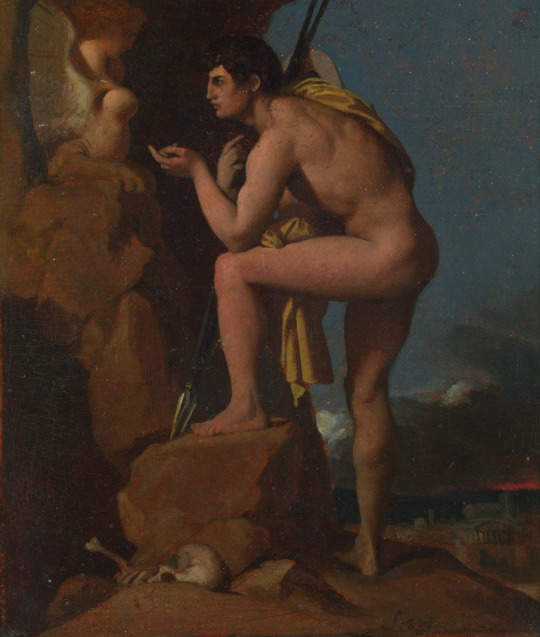
Jean Auguste Dominique Ingres (French, 1780 - 1867) Oedipus and the Sphinx, 1808 National Gallery, London Oedipus, a figure from Greek mythology, stands nude and in profile before the Sphinx, who guards the entrance to the ancient city of Thebes. The Sphinx – a monster with the face, head and shoulders of a woman, a lion’s body, and bird’s wings – asks Oedipus to solve the riddle she poses to all travellers seeking to enter the city: ‘What has a voice and walks on all fours in the morning, on two at noon, and on three in the evening?’ Oedipus correctly answers that it is man who crawls on all fours as a child, walks on two legs as an adult, and uses a walking stick as a third leg in old age. The bones of a previous traveller, killed by the Sphinx for having failed to solve the riddle, lie at the bottom of the picture. Thebes is visible in the distance on the right.
The theme of a monster defeated by human intelligence clearly appealed to Ingres. The picture also complements another of his paintings, Angelica saved by Ruggierro, which shows a chivalrous knight attacking a sea monster to save a princess. But this is also a painting of a man facing his destiny, as Oedipus’s actions will lead him to become King of Thebes, as the oracle predicted at his birth, and to unknowingly marry his own mother, Jocasta. This unwitting tragedy and its consequences is the drama of Oedipus Rex, the middle play of Sophocles' Theban Plays.
This painting is a later, and smaller, version of one painted in 1808 and subsequently reworked in 1827 (Louvre, Paris). The first version of Oedipus and the Sphinx was essentially a figure study that Ingres painted while studying at the French Academy in Rome. It was sent to Paris to be judged by members of the Institut de France. As required by the Institut’s rules, the figure of Oedipus was based upon a live model, although the pose was derived from the classical statue, Hermes Fastening his Sandal (Louvre), a Roman marble copy of a lost Greek bronze. Oedipus’s body is presented as an arrangement of geometrical shapes; for example, the triangle formed by his left arm, thigh and chest is mirrored and inverted by his left upper arm and forearm. The use of profile for both Oedipus and the Sphinx, together with the shallow space in much of the picture, recalls classical friezes and ancient Greek vases, which Ingres used as the sources for his deliberately classical artistic style.
#Jean Auguste Dominique Ingres#French art#mediterranean#art#fine arts#1800s#fine art#european art#classical art#europe#european#oil painting#europa#mythology#mythological art#classical#Oedipus and the Sphinx#1808#painting#artwork
118 notes
·
View notes
Text
In previous testimony, many defendants told the court that they couldn’t have imagined that Dominique Pelicot was drugging his wife, and that they were told she was a willing participant acting out a kinky fantasy.
Dominique Pelicot has previously tearfully acknowledged in court that he’s guilty of the allegations against him. He said all of his co-defendants understood exactly what they were doing when he invited them to his home in Provence between 2011 and 2020 to have sex with his unconscious and unwitting wife, who divorced him after learning what he had done to her. He had no difficulty finding dozens of men to take part.
The other men are only facing up to ten years, and I’m not buying the oh we didn’t know it was rape. She was fucking snoring in some videos, they were told to not make too much noise and to warm their hands. They knew they were raping a defenseless woman.
7 notes
·
View notes
Note
Hey! Wcif the hair Dominique is wearing in your profile picture? Thank you a lot!!

Hiiii!! It's a mesh edit I made for Dom using the hair from the Home Chef Hustle kit + adding his blonde streak overlay 🤭
29 notes
·
View notes
Text
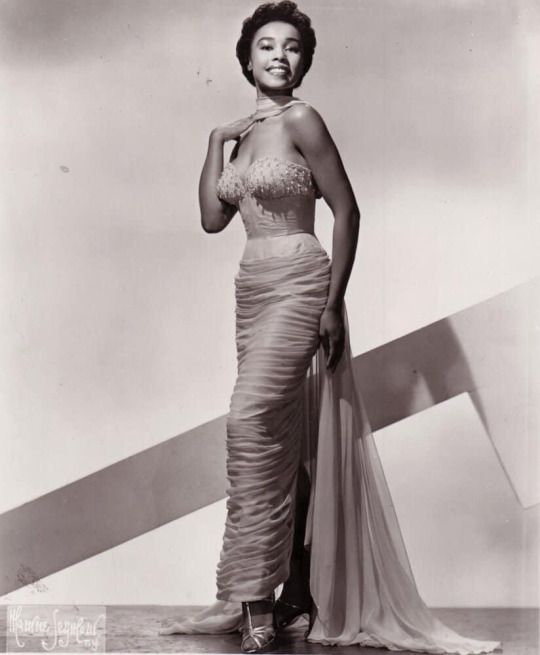
Carol Diann Johnson was born in the Bronx, New York City, on July 17, 1935, to John Johnson, a subway conductor, and Mabel (Faulk), a nurse. While Carroll was still an infant, the family moved to Harlem, where she grew up except for a brief period in which her parents had left her with an aunt in North Carolina. She attended Music and Art High School, and was a classmate of Billy Dee Williams. In many interviews about her childhood, Carroll recalls her parents' support, and their enrolling her in dance, singing, and modeling classes. By the time Carroll was 15, she was modeling for Ebony. "She also began entering television contests, including Arthur Godfrey's Talent Scouts, under the name Diahann Carroll." After graduating from high school, she attended New York University, where she majored in sociology, "but she left before graduating to pursue a show-business career, promising her family that if the career did not materialize after two years, she would return to college.
Carroll's big break came at the age of 18, when she appeared as a contestant on the DuMont Television Network program, Chance of a Lifetime, hosted by Dennis James. On the show, which aired January 8, 1954, she took the $1,000 top prize for a rendition of the Jerome Kern/Oscar Hammerstein song, "Why Was I Born?" She went on to win the following four weeks. Engagements at Manhattan's Café Society and Latin Quarter, nightclubs soon followed.
Carroll's film debut was a supporting role in Carmen Jones (1954), as a friend to the sultry lead character played by Dorothy Dandridge. That same year, she was nominated for a Tony Award for Best Featured Actress in a Musical for her role in the Broadway musical, House of Flowers. A few years later, she played Clara in the film version of George Gershwin's Porgy and Bess (1959), but her character's singing parts were dubbed by opera singer Loulie Jean Norman. The following year, Carroll made a guest appearance in the series Peter Gunn, in the episode "Sing a Song of Murder" (1960). In the next two years, she starred with Sidney Poitier, Paul Newman, and Joanne Woodward in the film Paris Blues (1961) and won the 1962 Tony Award for Best Actress in a Musical (the first time for a Black woman) for portraying Barbara Woodruff in the Samuel A. Taylor and Richard Rodgers musical No Strings. Twelve years later, she was nominated for an Academy Award for Best Actress for her starring role alongside James Earl Jones in the film Claudine (1974), which part had been written specifically for actress Diana Sands (who had made guest appearances on Julia as Carroll's cousin Sara), but shortly before filming was to begin, Sands learned she was terminally ill with cancer. Sands attempted to carry on with the role, but as filming began, she became too ill to continue and recommended her friend Carroll take over the role. Sands died in September 1973, before the film's release in April 1974.
Carroll is known for her titular role in the television series Julia (1968-71), which made her the first African-American actress to star in her own television series who did not play a domestic worker. That role won her the Golden Globe Award for Best TV Star – Female for its first year, and a nomination for an Primetime Emmy Award in 1969. Some of Carroll's earlier work also included appearances on shows hosted by Johnny Carson, Judy Garland, Merv Griffin, Jack Paar, and Ed Sullivan, and on The Hollywood Palace variety show. In 1984, Carroll joined the nighttime soap opera Dynasty at the end of its fourth season as the mixed-race jet set diva Dominique Deveraux, Blake Carrington's half-sister. Her high-profile role on Dynasty also reunited her with her schoolmate Billy Dee Williams, who briefly played her onscreen husband Brady Lloyd. Carroll remained on the show and made several appearances on its short-lived spin-off, The Colbys until she departed at the end of the seventh season in 1987. In 1989, she began the recurring role of Marion Gilbert in A Different World, for which she received her third Emmy nomination that same year.
In 1991, Carroll portrayed Eleanor Potter, the doting, concerned, and protective wife of Jimmy Potter (portrayed by Chuck Patterson), in the musical drama film The Five Heartbeats (1991), also featuring actor and musician Robert Townsend and Michael Wright. She reunited with Billy Dee Williams again in 1995, portraying his character's wife Mrs. Greyson in Lonesome Dove: The Series. The following year, Carroll starred as the self-loving and deluded silent movie star Norma Desmond in the Canadian production of Andrew Lloyd Webber's musical version of the film Sunset Boulevard. In 2001, Carroll made her animation debut in The Legend of Tarzan, in which she voiced Queen La, ruler of the ancient city of Opar.
In 2006, Carroll appeared in several episodes the television medical drama Grey's Anatomy as Jane Burke, the demanding mother of Dr. Preston Burke. From 2008 to 2014, she appeared on USA Network's series White Collar in the recurring role of June, the savvy widow who rents out her guest room to Neal Caffrey. In 2010, Carroll was featured in UniGlobe Entertainment's breast cancer docudrama titled 1 a Minute and appeared as Nana in two Lifetime movie adaptations of Patricia Cornwell’s novels: At Risk and The Front.
In 2013, Carroll was present on stage at the 65th Primetime Emmy Awards to briefly speak about being the first African-American nominated for a Primetime Emmy Award. She was quoted as saying about Kerry Washington, nominated for Scandal, "She better get this award."
Carroll was a founding member of the Celebrity Action Council, a volunteer group of celebrity women who served the women's outreach of the Los Angeles Mission, working with women in rehabilitation from problems with alcohol, drugs, or prostitution. She helped to form the group along with other female television personalities including Mary Frann, Linda Gray, Donna Mills, and Joan Van Ark.
Carroll was diagnosed with breast cancer in 1997. She said the diagnosis "stunned" her, because there was no family history of breast cancer, and she had always led a healthy lifestyle. She underwent nine weeks of radiation therapy and had been clear for years after the diagnosis. She frequently spoke of the need for early detection and prevention of the disease. She died from cancer at her home in West Hollywood, California, on October 4, 2019, at the age of 84. Carroll also had dementia at the time of her death, though actor Marc Copage, who played her character's son on Julia, said that she did not appear to show serious signs of cognitive decline as late as 2017. A memorial service was held in November 24, 2019, at the Helen Hayes Theater in New York City.
#carroll#emmy award#neal caffrey#carol diann johnson#carol johnson#african#afrakan#kemetic dreams#brownskin#africans#brown skin#afrakans#bronx#new york#los angeles#marc copage#october#julia#helen hayes theater#west hollywood#california#kerry washington#scandal#mary frann#linda gray#donna mills#joan van ark#breast cancer#diagnosis
95 notes
·
View notes
Text
In the four years after she discovered her husband had been drugging her and inviting strangers into their home to rape her, Gisèle Pelicot liked to walk to clear her head.
Striding through the countryside alone, she would throw the questions that tormented her to the wind: “Dominique, how could you have done it? Why did you do it? How did we get here?” Asked what she was doing when she was disappearing for hours, she would tell her three children: “I am talking to your father.”
From his prison cell, Dominique Pelicot, who has admitted orchestrating the rapes at the couple’s home in the Provençal town of Mazan, could not answer. Nor would he when facing his former wife across a crowded courtroom, except to say: “I am a rapist … like the others in this room.”
The 50 men who appeared alongside him, charged with aggravated rape and sexual abuse, have also failed to explain their actions.
Why, when confronted with the inert body of a drugged and unconscious woman, did these “ordinary men”, as they were described in court, with ordinary names – Laurent, Nicolas, Philippe, Christian, Hassan – not leave? Why did not one of them go to the police and put an end to the decade-long abuse of a woman that could have killed her?
“The question is not why you went there, but why you stayed,” one of Gisèle Pelicot’s lawyers, Antoine Camus, told the court.
Camus cannot imagine why the men, who he says represent a “kaleidoscope of French society”, did so except for a lack of empathy towards their victim, who he says was treated as “less than nothing”.
As the trial enters its final days this week, the accused will be permitted a last word on Monday before the president of the court and five judges known as “assessors” withdraw to consider their verdicts and sentences. The public prosecutor has demanded a maximum prison term of 20 years for Pelicot and sentences of between four and 18 years for the 50 others.
Then, Gisèle Pelicot will walk out of court for the last time, flanked by her two lawyers, Camus and Stéphane Babonneau, who have protected her like praetorian guards every day. There will be a last round of applause and cheers from the crowd – mostly women – who have arrived at dawn to queue for hours outside the courthouse for a place in the hearing, and who have presented her with gifts and shouted “Merci, Gisèle!” as she left each evening.
A criminal trial aims to answer questions. During this three-and-a-half-month hearing, the accused have produced excuses but few answers.
Sitting in court, we listened to the men arguing that Pelicot had given his consent for them to rape his wife; that they had not “intended” to rape her; that what they had done was not rape; that they did not have the profile of a rapist and therefore were not one. That they believed Gisèle Pelicot was only pretending to be asleep. That they had too much testosterone – that it was their body, not their brain, acting. That they too were victims of her manipulative, perverse husband.
With Gisèle Pelicot unconscious and unaware of what was being done to her, the videos her husband recorded of the assaults were, as the public prosecutor pointed out, “worth a thousand words”. In them, we saw Pelicot directing his personal pornographic scenes, moving his unconscious wife – dressed in lingerie that was not hers and with crude messages written on her buttocks – into positions, holding her mouth open, whispering to his cast of naked strangers to “get on with it”, to do this, do that, or to get out if she so much as twitched. Defence lawyers tried to have those recordings struck out as evidence.
“It is evident that Mme Pelicot was not in a normal conscious state,” public prosecutor Laure Chabaud said.
“She was in a state of torpor closer to a coma than sleep. [This] didn’t seem to dissuade the participants, none of whom spoke to Gisèle Pelicot or sought her consent.”
Several of the accused did admit there was something bizarre about the scenario, as Pelicot instructed them to get undressed and warm their hands on the radiator because his wife was “sensitive to the cold”. But they stayed anyway. A few realised their “mistake” and were sorry. Others were almost defiant, shocked they were in court. Most deny rape.
Those facing the gravest accusations, of up to six counts of rape, sat in a second glass box on the left of the courtroom, stroking their chins, fiddling with their beards, bowing their heads or complaining to their guards that journalists were “looking at them meanly”. Those on bail and free to come and go went in and out of the courthouse with collars pulled up, hats pulled down and masks hiding their faces.
Giving evidence, the Pelicots’ younger son, Florian, dismissed the men as “not la creme de la creme”, but they looked ordinary enough in their jeans and leather jackets, anoraks, trainers and hoodies. Their backgrounds were varied and in other circumstances might have provoked sympathy – broken homes, childhood abuse, drug and alcohol problems – but there was no common thread. Many had no previous criminal record, although some were charged with possession of child abuse or bestiality images. They were all functioning adults, most with jobs, children and partners.
For Camus, their excuses are evidence of French society’s “culture of rape” being played out in real time. “These absurd suggestions, prejudices, hypotheses, preconceived ideas … all deployed before our very eyes, and all at the expense of Gisèle Pelicot,” he says.
In court, she would stare at them or the ceiling, listen to their excuses, dismiss their apologies, her face impassive. “She is disgusted, appalled and indignant … but not surprised,” Camus adds. Her reaction was the same as it had been when she had first seen the videos in the run-up to the trial: how could they? “She was waiting for the explanations, some kind of exchange, and she has not had that.”
The depravity of what the world has seen and heard will not be easily erased from the memory.
“We thought we knew everything men were capable of inflicting on women but never imagined a husband drugging his wife and offering her up to dozens of predators for 10 years,” said one woman who has been attending court to support Gisèle Pelicot.
The case has also raised broader questions over the toxic masculinity riddling French society, how the police, courts and society treat rape victims, the use of drugs in rape, and, of course, consent, or the absence of the concept in French law. In France, rape is defined as “sexual penetration, committed against another person by violence, constraint, threat or surprise”. The Mazan rapes have been shoehorned into the “surprise” category – but feminist groups are divided over whether adding consent to the law would be a good thing or simply place undue focus on the victims.
Statistics from the Institut des Politiques Publiques in France suggest that over a 10-year period there were more than 400,000 cases of sexual violence in France, 86% of which resulted in no action and only 13% in conviction. There are about 700,000 cases of domestic abuse each year, only 27% ending in conviction. Campaigners are hoping the Pelicot trial will signal a watershed in a country where the #MeToo movement has struggled to maintain much impetus.
The case has been shocking because of its scale and perversity, but we have been here before. In 2018, as French women began to open up about sexual abuse in the wake of the Harvey Weinstein scandal, a collective of 100 women, including the grande dame of French cinema, Catherine Deneuve, wrote an open letter saying it had all gone too far and was stifling men’s ability to seduce.
Blandine Deverlanges, a teacher and founder of the local feminist group Amazons of Avignon, says the Pelicot trial is already encouraging other rape and sexual assault victims to speak out. “Gisèle Pelicot has offered us her story and it is our story. She has held her head high and in doing so encouraged other women hesitating over whether to report rapes to come forward.”
The Avignon trial lies on a continuum that began in France in 1974, in Aix-en-Provence, when another Gisèle, feminist lawyer Gisèle Halimi, represented Anne Tonglet and Araceli Castellano, two Belgian women who had been raped by three men while camping.
Like Pelicot, they also waived their anonymity and refused a closed-door hearing at a time when rape was treated as a public indecency misdemeanour under laws that dated back to the Napoleonic era. Halimi said at the time: “You must convict these three men, because otherwise you will condemn women to never again be believed.” The men were convicted and the trial led to a rewriting of France’s criminal code.
Agnès Fichot, a lawyer who worked with the late Halimi on the case, says attitudes have changed in the past 50 years, but there is “still a long way to go”.
Fichot argues the law does need a “consent” clause but that the burden of proof should be inverted. “It should not be for the victim of rape to prove she consented, but for the man to prove he had her express and clear consent,” she says.
Fichot has attended the trial and is astonished that none of the men recruited by Pelicot had considered reporting him. She is dismayed by their refusal to take responsibility for their actions. “Not one of them came out of that house and thought of going to the police to say there was a woman in danger, to tell of the horrors her husband was inflicting, so she could be saved.”
The videos ruled out suspicions, fostered by some defence lawyers, that Gisèle Pelicot had been complicit in the abuse. Still, they questioned her about her sex life – whether she was a swinger, an exhibitionist, an alcoholic, a manipulated and subjugated wife. One asked why she had not appeared angrier with her former husband, and why she had not cried more in court. As more videos were shown, the questions seemed as obscene as the images we were watching.
“I went to court hoping the [defence] arguments would be changed since the 1970s but they had not,” says Fichot. “The testosterone excuse was the absolute worst. It was the archaic argument that males, who have all the privileges and domination over women, have this weakness and we cannot blame them for it because they are male and have uncontrollable urges.”
It took four years after Pelicot, a retired electrician, was arrested in November 2020 for the case to come to trial. Until she walked into court in September this year, Gisèle Pelicot had not seen the man she once considered a “perfect, loving, attentive and caring” husband, father and grandfather, who she had been married to for 50 years, since he had been taken into custody.
On 2 November 2020, the couple left their neat home with a swimming pool, where they had intended to spend their retirement, to drive to the police prefecture in Carpentras. Six weeks earlier, Dominique Pelicot had been arrested for filming up the skirts of four women in the Leclerc supermarket. He had made a tearful confession to his wife, promised not to do it again and to seek medical help. He told her on this occasion they would be home by lunchtime.
But at the police station, a senior officer showed Gisèle Pelicot some photographs and told her what her husband had been doing to her for almost a decade. After the shock came the indignation that prompted the decision to waive her anonymity and insist that the trial – including appalling videos described by Roger Arata, the president of the court, as “particularly offensive to human dignity” – be held in public so that “shame changes sides”.
It was a decision that made the 73-year-old grandmother internationally recognised and gave feminists a new slogan.
“We warned her holding the trial in public would cause a storm, but it meant the outside world could look in and see exactly what had happened,” Camus says.
His fellow lawyer Babonneau says Pelicot’s determination that this should not happen to another woman is her driving motivation. “Normal people need to read about it to be aware it can happen. She was an ordinary woman, a pensioner living in the south of France … what could she expect from life: no trauma, no dramatics, a nice house in a nice village and she thought this would be her life for ever.”
Babonneau and Camus are struck not just by her former husband’s manipulation but his cynicism. The drugs he had been giving her had caused blackouts and memory loss. She had inexplicable gynaecological problems, and was convinced she had a brain tumour or degenerative neurological disease.
Her children had persuaded her to see specialists. She was accompanied by her husband, who did not once try to ease her fears.
“When she was tired, when she said she had gynaecological problems, Dominique would joke: ‘Gisèle, what are you doing at night?’ It is beyond belief. Disgusting,” Camus says.
He likens her betrayal to that of the moment in The Truman Show when the film’s main character discovers his existence has been a reality television programme. “He discovers that everything he believed was real is false … For Gisèle, it has been the same, except it was a pornographic film and the director was her husband.”
The trial will indelibly mark all those who spent time at it. Reporters who jostled for a seat in the small courtroom listened to Arata read the list of alleged crimes for each accused in a monotone, as if repeating a weekly shopping list: digital penetration, vaginal penetration, oral penetration, anal penetration, sexual touching. We would hear the most appalling evidence, see the most appalling videos and think nothing could be worse. Except the next day it often was.
Marion Dubreuil, court correspondent for the French radio station RMC, was there almost every day, live-tweeting and sketching those in the courtroom. “What saved me was documenting it,” she said. “I found sense in my work.
“I tell myself: this trial will change things. Rape is the most absolute crime; the most banal and the most common. Now we are speaking about it, people realise it is happening all the time. I see this in those around me. The trial has made them think.”
The public prosecutor, Jean-Marie Huet, who had originally wanted the case to be held behind closed doors, admitted to Gisèle Pelicot he had been wrong. “I salute your courage, madame, and your dignity throughout these proceedings,” he said. “We asked for a closed-door hearing without knowing the force of your character.
“In an incredible burst of resilience, you asked for a public hearing, and you were right, madame.”
Sitting in a local cafe, Camus taps the table irritably when reminded of the defence lawyers who have attacked Gisèle Pelicot.
“When people say she is not feeling enough hate, that she doesn’t cry enough … I ask, what do people want of her?” he says. “What do they expect her to do? Kill herself? That she is still standing is a testament to her amazing resilience.
“My preoccupation, my obsession since the beginning of this trial, is that she does not come out of it more damaged than when she went in and, in fact, I have the impression she has come out of it strengthened. She went into it very fragile with her head held high and she has come out of it … with a sort of pride.
“People will remember Gisèle Pelicot because there are many lessons to be learned from her and this trial. She is a monument, she raised her head, she lives, she refuses to be swallowed by the shadows or by hate.”
It is the job of courts to ask questions and dig out the answers. Reporters, too. In this instance, we have both failed. The question of how so many men were able to dehumanise Gisèle Pelicot will take psychologists and social anthropologists some time to unravel.
(archive)
320 notes
·
View notes
Photo

(via Adèle Haenel Quits Acting, Writes Scathing Letter on French Film Industry Protecting Rapists)
French actress Adèle Haenel, most famous for her role in the Cannes-prize-winning Portrait of a Lady on Fire, announced her retirement from the film industry in her country in a scathing open letter published on Tuesday. Haenel wrote that people in power in the industry have ignored high-profile sexual misconduct scandals that have come to light in France since #MeToo and “joined hands [to protect] the [Gerard] Depardieus, the [Roman] Polanskis, the [Dominique] Boutonnats,” referring to some of the men behind these scandals.
“It bothers them that the victims make too much noise. They preferred that we disappear and die in silence,” she wrote of leaders in her industry. “They’re ready to do anything to defend their rapist chiefs, those who are so rich that they believe they belong to a superior species, those who make a show of this superiority by… objectifying women and subordinates.”
the times are indeed changing
slowly but surely
82 notes
·
View notes
Text
Imitated DID Reloaded
(Part 1, Part 2)
After the controversies of the 80s and 90s, the publications of the imitated DID theory and the rename from MPD, DID diagnosis rates and public awareness of the disorder overall plummeted. Recently though, it's been picking up steam online, which led to a revival of the Imitated DID theory.
Clinicians identified five themes common in these cases they deemed to be imitated.
But before touching those...
An important note on methodology.

Notice the name at the front of the paper on the TADS-I, Boon, is also one of the authors of this study, and of the original Imitated DID paper.
Looking up the TADS-I immediately links to Suzette Boon's own website.
In the limitations section, it's mentioned that TADS has yet to be validated.

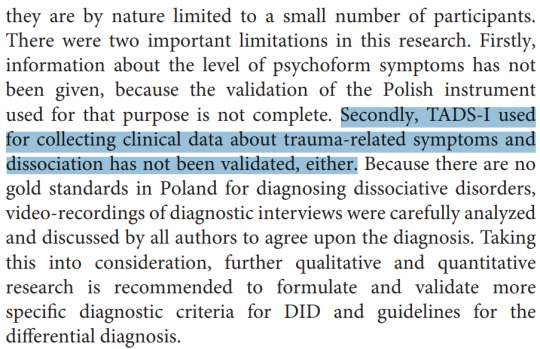
So Suzette Boon and colleagues used Suzette Boon's unvalidated interview (TADS-I) to assess patients for having a condition originally made up by Suzette Boon. (Imitated DID.)
With that note on methodology, let's dive right in and address everything wrong with the themes!
The Themes
Theme 1: Endorsement and Identification With the Diagnosis
In a modern era, it's pretty common for ordinary people to research a disorder they think they may have. Especially if a mental health professional suggests the diagnosis first, as happened in four of the six cases listed...

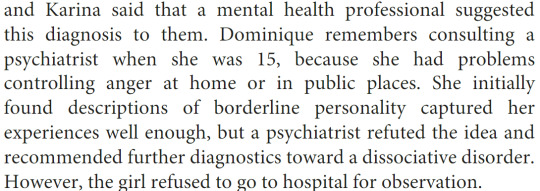
If someone says "I think you might have this disorder," MOST young people today are going to look on the internet to determine if it matches up. We literally have this ability in our pocket. Of course we'll use it.
And if you want to establish a theme like this, then you should generally have some type of control group to compare it to.
These were six people out of 85. There are no percentages given of the other 79 who had identified with the disorder beforehand. There are no statistics of how many looked it up online. It seems like it would be easy to get these sorts of stats to test their hypothesis but they aren't there.
Theme 2: Using the Notion of Dissociative Parts to Justify Identity Confusion and Conflicting Ego-States
This one is a bit harder to parse.
The idea here seems to be that people who have conflicting feelings or identity confusion will attribute that to alters.
The problem with this, similar to the first one, is that there's no comparison to actual DID groups.
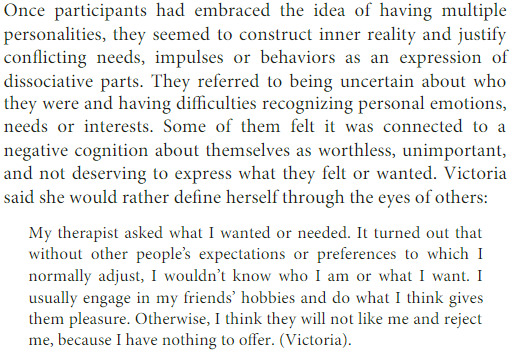
Victoria lacks a firm sense of identity. And I think it's fair to say her acting in different ways to different people probably isn't a different alter every time. But it's possible and common to experience a lack of identity like this, while also having a complex dissociative disorder.
I can't assess whether she has DID or OSDD, but I don't think experiences like this are indicative of her not having it, and I know many DID systems would relate to her not having much of an identity.
2.1: Dominique and Partial DID
The next example in this section is about Dominique.
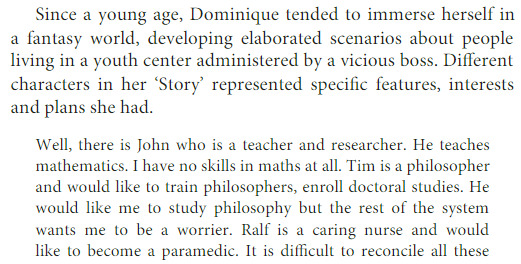
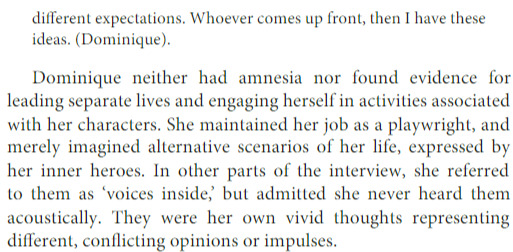
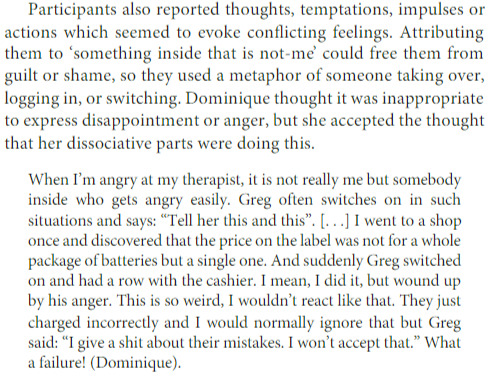
The reason for dismissing Dominique having DID is that her characters don't live separate lives or have amnesia. And it's possible she may not have it.
But what's never mentioned once in this paper is Partial DID. This paper was published after the ICD-11, and even uses the ICD-11 for its DID criteria. But the profile for Partial DID is never mentioned in the paper.
From the ICD-11
Partial dissociative identity disorder is characterised by disruption of identity in which there are two or more distinct personality states (dissociative identities) associated with marked discontinuities in the sense of self and agency. Each personality state includes its own pattern of experiencing, perceiving, conceiving, and relating to self, the body, and the environment. One personality state is dominant and normally functions in daily life, but is intruded upon by one or more non-dominant personality states (dissociative intrusions). These intrusions may be cognitive, affective, perceptual, motor, or behavioural. They are experienced as interfering with the functioning of the dominant personality state and are typically aversive. The non-dominant personality states do not recurrently take executive control of the individual’s consciousness and functioning, but there may be occasional, limited and transient episodes in which a distinct personality state assumes executive control to engage in circumscribed behaviours, such as in response to extreme emotional states or during episodes of self-harm or the reenactment of traumatic memories. The symptoms are not better explained by another mental, behavioural or neurodevelopmental disorder and are not due to the direct effects of a substance or medication on the central nervous system, including withdrawal effects, and are not due to a disease of the nervous system or a sleep-wake disorder. The symptoms result in significant impairment in personal, family, social, educational, occupational or other important areas of functioning.
This sounds a lot like what's described with Dominique.
Of course, Dominique could be a non-disordered system too.
What I find concerning is that at no point is the possibility of Partial-DID or of OSDD brought up. It's expected to be DID or nothing for the purposes of this study.
Another thing I need to say... alters aren't usually heard acoustically. I believe they can be in some cases, but it's not the majority. So I don't understand why that was relevant unless the authors misunderstand how voice hearing typically manifests.
2.2 "No participant provided evidence..."

I'm so curious what evidence people were expected to provide. As a reminder, in the last paper, being too open about talking about your alters or describing your switches was seen as a sign of Imitated DID. And it's the same in other parts of this paper.
How do you go about providing evidence for an autonomous dissociative part?
Theme 3: Exploring Personal Experiences via the Lens of Dissociation

There's not much to say about this one either. People who think they have a disorder begin relating experiences to those disorders. Like with all the other "themes" discussed, there is no comparison to the "genuine" DID group, many of whom would likely also have conducted similar research.
People who have autism, for example, will analyze their behavior and wonder how much of it is because of the autism. Same with ADHD, and various personality disorders.
Theme 4: Talking About DID Attracts Attention
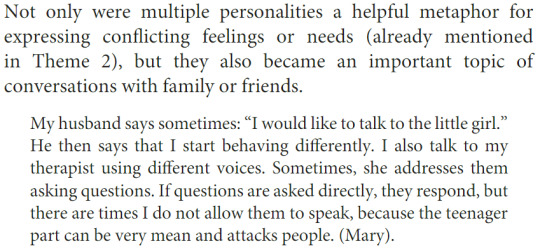
Again, no comparison is made to a "genuine DID" group who is out to friends and family. It's likely that, yes, DID is going to be a topic of conversation for those who are out. But the same is true of many conditions.
"People who are imitating DID talk about having DID" wouldn't be a helpful distinction if people who aren't imitating DID also talk about having DID. (With close friends and people they trust.)
Theme 5: Ruling Out DID Leads to Disappointment or Anger
And like with every other theme in this, there's no comparison to the "genuine" DID group.
If you lied and told the other 80 participants that they didn't have DID, how would they react???
I don't know. Because that study was never conducted.
I predict a lot of DID systems who had been diagnosed by others and identified with the label would react the same way though.
This point feels especially insidious, as it's designed to reinforce a clinicians' belief that they made the right decision after saying someone doesn't have DID.
"Well, you got upset when I told you that you didn't have this condition you're certain you had, therefore I'm even more right that you don't have it."
It can't even possibly help you diagnose because it only comes later. It's only about validating the clinicians after the fact.
All these "Themes" have the same flaw
The themes are derived from six case studies (way too small of a sample size) of so-called "imitated" DID. But there's no comparison to genuine DID. No statistics to show that these same themes wouldn't be present in a majority of "genuine" DID cases too.
In other words, these themes have zero utility in differentiating between DID and non-DID phenomena.
Return of the Shame Criterion
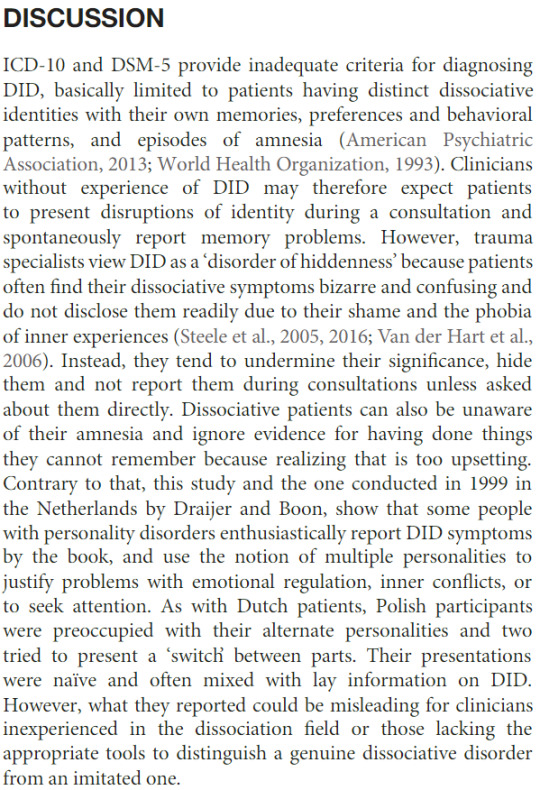
Homosexuality was much more hidden and shameful in the 80s than it is today. The same is true of transness. And the same is actually true of many mental illnesses too. We can talk about our own autism more openly than someone could in the 80s.
Shame is often not simply based on the individual but on the culture and the subcultures they exist in.
Like I addressed in the first post in this series, certain disorders, conditions and just general personality types may make someone less ashamed of traits others would be ashamed of.
But more than that, expected shame can change as a culture changes and we become more accepting. And THAT'S A GOOD THING. We should all WANT a world where people with DID can feel less ashamed of themselves. The expectation of shame, the requirement of shame to be seen as valid, is something we need to fight against.
Here's a post I made on that particular subject.
And let me just make another note on these particular patients: These are not people who had just newly been diagnosed. They've had time to heal and come to terms with what they are, and build connections with the rest of their alleged systems.
Someone who has known about their DID for three years will generally have less shame for symptoms than they might have at 1 month.
This section also appears at odds with the earlier implication that patients show evidence of "dissociative parts," creating a very unfortunate paradox where you need to provide proof, but trying to provide proof is evidence of faking.
Other symptoms of DID

Luckily, the paper doesn't just talk about themes. It also discusses symptoms. So maybe these will hold up better to scrutiny.
Voices

I'm genuinely worried by this that the doctors don't understand the internal experiences of the disorders they're diagnosing.
As far as I know, this is how voices typically present in DID. Earlier on, it mentioned that Dominique didn't report an "acoustic" quality to the voices. But that's how the voices typically work. Acoustic voices are possible too, but voices heard are typically mind voices.
The way this is phrased makes me think the doctors were expecting patients to all have vivid acoustic voices.
And I believe this misconception led to a miscommunication with Mary, who clearly is describing parts talking to her.
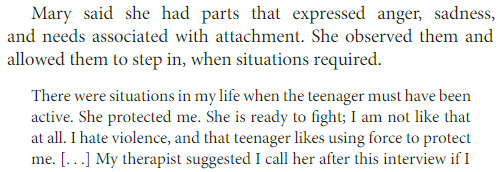

But allegedly later denied "hearing voices."
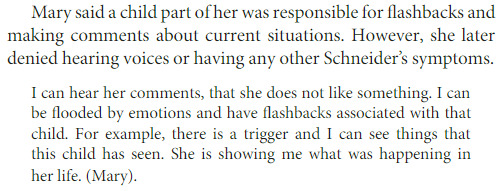
My own interpretation, at least, is that Mary was probably confused and thought the clinicians were asking about actual audible voices. Which it actually sounds like they might have been.
Voice hearing is complicated, and this paper is written in a way which might add more confusion, making readers falsely believe that alters will always speak in these sorts of acoustic voices rather than mindvoices resembling internal thoughts.
This sort of misunderstanding is genuinely dangerous to patients.
Amnesia
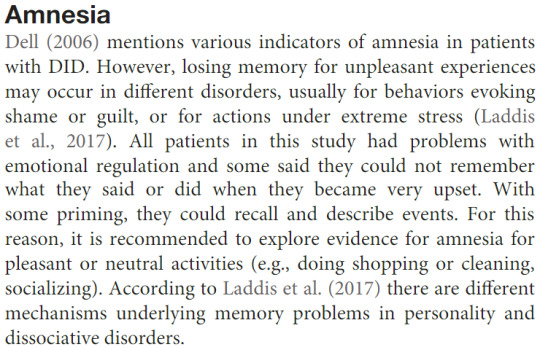
There are a couple points that need to be made about Amnesia.
First: Under the DSM, there is a presentation of OSDD that includes all the symptoms of DID but without the amnesia. In the community, we typically refer to this as OSDD-1b.
Second: Under the ICD-11, while described as "typically present," amnesia isn't even a hard requirement for a DID diagnosis as seen below:
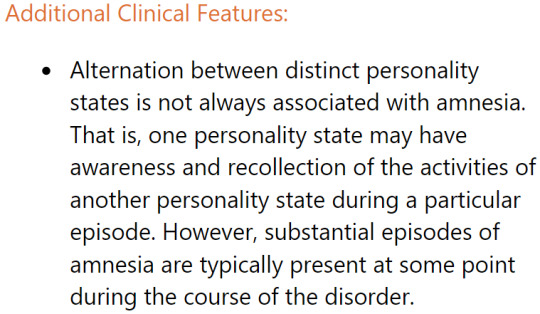
Third: Partial DID in the ICD-11 also had no amnesia feature at all. At no point is this or OSDD brought up.
Focus on the amnesia criterion here, while necessary for a diagnosis of DID under the DSM-5, doesn't address larger questions of if the patients might have disorders involving "dissociative parts."
The fact that these other disorders exist where amnesia isn't required NEEDS to be addressed this paper.
Language
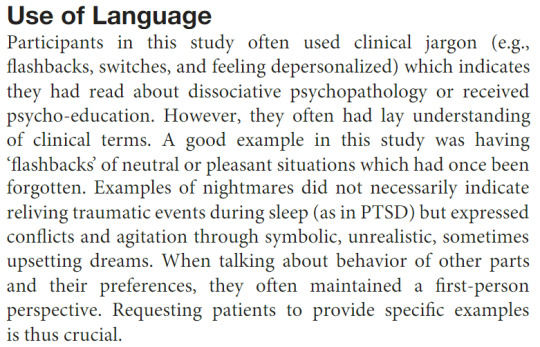
This is somewhat good advice. I'm against the implication that knowing jargon, for patients who have been told by other clinicians that they have a dissociative disorder, is an indicator of imitated DID.
But I do very much agree with the fact that people who use these terms don't often understand them and you need to ask questions that go beyond the terms selves. Getting someone to describe a flashback is more useful than them saying they have flashbacks, when they may just mean they have vivid memories.
Although for the 1st person perspective, this may just be different ways of contextualizing the same experience, or even trying to phrase things in ways they thing a singlet will understand. I think, for a paper that tries to beat people over the head with how DID is usually a "disorder of hiddenness," they're ignoring how referring to yourselves in the 1st person with other people becomes habitual.
Not to mention that certain parts of the DID community even believe it's healthier to refer to everything they do as a system using singular pronouns, viewing it as a form of system responsibility.
Depersonalization

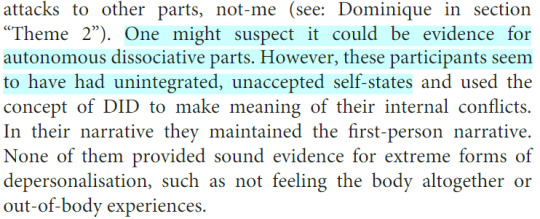
Are "self-states" not autonomous?
What... actually is the difference between an autonomous dissociative part and an autonomous unintegrated self-state with its own name and identity?
Is there a way to reliably differentiate between these concepts?
Switches
This is the part that I feel rises to actual misinformation.
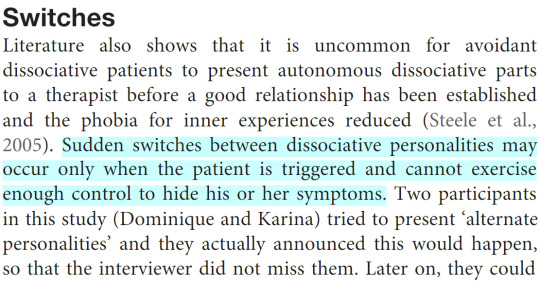
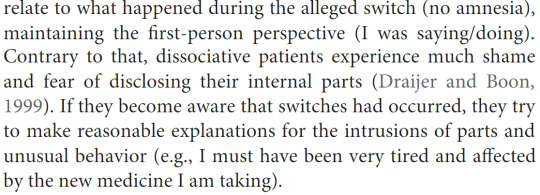
Before getting to the highlighted part, I'm going to point out that the source for the "shame and fear" of disclosing their internal parts is the study from the previous two posts.
The study THAT DIDN'T INCLUDE ANY EXAMPLES OF "GENUINE" DID CASES.
It was stated as a fact with no statistics or evidence to back it up whatsoever. And one of the authors, Suzette Boon, is also an author of this study. This "source" might as well be Suzette Boon quoting herself claiming something.
Now, to the highlighted part... this is complete misinformation.
I'm shocked it got published.
Some DID patients can, in fact, control switches. This has been observed in fMRI scans:

DID systems DO NOT need to be triggered to switch. This has been proven with actual brain scans, in addition to decades of reports in the literature.
And I need to repeat again that this group was also taken from people who were already in treatment for DID.
In other words, even if they couldn't control switching before, it would be something they likely would have picked up through treatment.
A Solution in Search of a Problem
Ultimately, this is a study which has little reason to exist. In their sample of 85 people, they found only six they claim had Imitated DID. Even if these assessments are were correct. Even if they weren't conducted by people who seem to not understand how switching or voice hearing works in DID... this would leave us with a 7% false positive rate.
Meanwhile... mentioned in this same paper...

26%-40% of DID patients will be diagnosed with and treated for Schizophrenia first. And this doesn't even address misdiagnosis of other disorders like BPD.
Imitated DID continues to be a solution in search of a problem.
But there is a very REAL problem of underdiagnosis and misdiagnosis of actual DID cases. Something that will only be exacerbated by convincing doctors that "genuine" DID systems can't possibly control switching (and anyone who does is faking), that voices heard are always acoustic, and that DID systems will always be ashamed of their symptoms.
Papers like this are going to result in fewer systems who need help being able to get a diagnosis.
#psychiatry#psychology#syscourse#plural#sysblr#system#plurality#pro endo#pro endogenic#system stuff#imitated dissociative identity disorder#multiplicity#systems#plural system#endogenic system#science#medicine#doctors#mental health#actually a system
40 notes
·
View notes